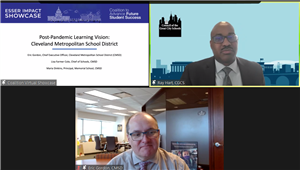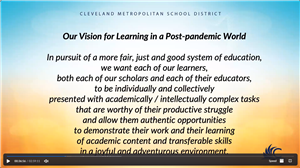- Council of the Great City Schools
- Tracking the Use of ESSER Funds in Cleveland
Digital Urban Educator - May 2023
Page Navigation
- Liz Cheney Among Speakers Set for 67th Annual Fall Conference
- Council Releases Report on Supporting Foundational Literacy for English Learners
- New Leaders Named in Charlotte, Cleveland, and Des Moines
- Dallas Boosts the Number of Hispanic and Black Students Taking Advanced Classes
- Tracking the Use of ESSER Funds in Cleveland
- Urban Students Selected as 2023 U.S. Presidential Scholars
Tracking the Use of ESSER Funds in Cleveland
-
The Coalition to Advance Future Student Success, an organization which the Council of the Great City Schools is a member of, recently held a virtual ESSER Impact Showcase highlighting how Elementary and Secondary School Emergency Relief Fund (ESSER) dollars are having an impact on schools and communities.

Council Executive Director Ray Hart noted that all of the Council’s urban school districts have been focused on wisely investing ESSER dollars to address the impact of the COVID-19 pandemic on teaching and learning.
“In particular, we have focused on recovering from the pandemic’s influence on student learning outcomes and we have numerous examples from across our districts on the types of investments that have directly impacted our students and families,” said Hart.
The impact of ESSER funds has greatly impacted the Cleveland Metropolitan School District, according to Chief Executive Officer Eric Gordon, who, along with two colleagues, shared how the district is investing ESSER funds at the district and school level to improve academic achievement.

Gordon said that during the Covid-19 pandemic, district-based and school-based educators made a pact when schools shut down for in-person learning that they were determined not to return to business as usual after the pandemic ended. As a result, they created a plan titled “Our Vision for Learning in a Post-Pandemic World” to help guide the district.
“We made a bet that if we invest in things such as out of school time and summer learning experiences that deepen and broaden the rich learning environment for young people in the context of rigorous academic content,” said Gordon, “we can move achievement, and we can use ESSER dollars to jump start this vision and then build a bridge to sustainability long term,” said Gordon.
Memorial School, a high-poverty preK-8 school with an African American student population, has seen positive results from the programs implemented using ESSER funds.
The school started 0/9 clubs for students in grades 5-8, in which an extra period is attached to the beginning or the end of the school day. The clubs teach students how to play musical instruments and there is also an art club, physical fitness club, and a choir that are very popular with students.
The school has an out-of-school time program, with 180 K-8 students enrolled in the initiative, nearly half of the school’s student body. Students in the program participate in a variety of activities, including learning Spanish, boxing, cheerleading, dance, and African drumming. The program also provides students with academic tutoring daily. “We have seen narrowing of learning gaps due to extra tutoring,” said Memorial principal Maria Dinkins.
District officials used ESSER funding to provide all schools with an additional $150 per student. Memorial used this funding to pay for additional teachers to tutor students at lunchtime and to provide professional development. After several staff attended a conference about responsive classrooms, the school implemented morning meetings where students and teachers gather together in the mornings to interact with one another. Dinkins credits the meeting with improving students’ social and emotional learning. “We’ve seen more focus on teachers building their relationships with students and focusing more on how students are feeling,” said Dinkins.
On a district level, the Cleveland school system has shifted to using Project Based Learning across all schools in an effort to expose students to rich academic content by creating interdisciplinary projects. The initiative started in the district’s summer learning experience program and has broadened to allow students in all schools to engage in projects.
In the area of technology, ESSER funds have been used to purchase Amira, a tutoring program that uses artificial intelligence as a real time coaching mechanism for students as they are reading. The program was piloted in four schools and will expand to 22 schools as part of the district’s summer learning experience. And the district used ESSER funds to put Clevertouch Smartboards in every classroom and to start the process of shifting to a one-to-one technology school district.
“We are really confident that by shifting the focus to complex tasks that are undergirded by literacy and numeracy and by leveraging ESSER funds to bring it to life that we are, in fact, doing what we dreamed to do and envisioned to do,” said Gordon.
Media Contact:
Contact Name
Contact@email.com
(000) 000-0000
Contact Name
Contact@email.com
(000) 000-0000
Contact Name
Contact@email.com
(000) 000-0000
Media Contact:
Contact Name
Contact@email.com
(000) 000-0000
Contact Name
Contact@email.com
(000) 000-0000
Contact Name
Contact@email.com
(000) 000-0000


